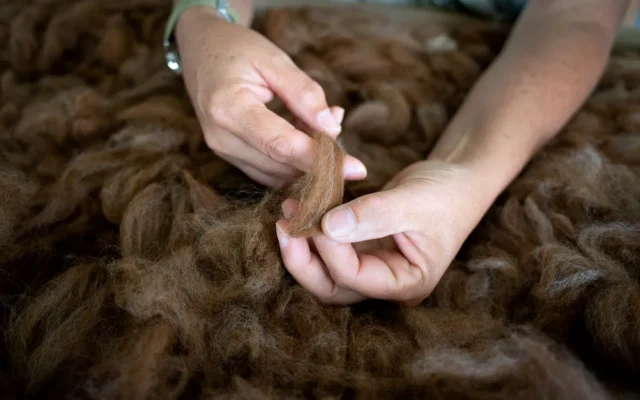
How this group plans to rebuild Maine’s fiber economy and soil
By Elizabeth Walztoni, Bangor Daily News Staff
A small Maine volunteer group has big plans to rebuild a regional industry in a way they believe will also benefit the environment, particularly soil, and human health.
To make it happen, the Maine Fibershed plans this year to found chapters in each county, work with local groups and research new uses for wool, adapting a national model as they go.
“Our job is to cut out the middleman and let farmers find the resources they need without going so far away that they lose money,” co-founder Pat Harpell said.

ALPACA FLEECE — Robin Pratt, co-owner of Northern Solstice Alpaca Farm in Unity, shows the quality of alpaca fleece from one of her alpacas in this 2021 photo.
Farmers, for these purposes, include people who raise fiber animals, plant fiber producers and those who grow plants for dye. In Maine, where fiber is mostly a small-scale industry, some farmers ship raw products as far away as the Midwest and even Utah for the expensive processing they need to make it to market.
As a concept, a “fibershed” is a regional system of these functions from production to compost, a similar concept to a watershed. As an organization, the first Fibershed has been based in California since 2010; another affiliate covers Northern New England. All describe their vision as “soil-to-soil.”
The Maine Fibershed became formally affiliated with both larger groups last year. They’ve made some adjustments, Harpell said. For instance, marketing photos of desert models don’t match the plain-spoken, independent farmers she knows, and the provided site animations would crash on most rural internet connections.
But the national affiliation provides resources, and it has established farm practices designed to capture and store carbon. The California group reported the practices used in 2023 will be equivalent to taking 5,200 gas-powered cars off the road in the next 20 years. It works with the U.S. Department of Agriculture administering grants to use these soil-focused practices.
Because Maine is so large and rural, and has many of its economic resources concentrated around its few cities, the local fibershed plans to roll out a group in each county this year. Those groups can identify the needs and opportunities unique to each area.
It has already connected people to resources they didn’t know existed, Harpell said, like new fiber mills that can process locally. A directory developed over the past year lists producers and processors.
Bringing back fiber processing is one goal. Finding uses for it outside of textiles is another.
Sheep that aren’t bred specifically for fiber yield lower quality wool not suited for yarn. The animals still need shearing for their health, and even on good quality sheep, about 20 percent of a fleece is unusable.
Many farmers burn or throw away this wool because it costs more to process than it’s worth, especially for small flocks.
But using wool as a soil amendment has been gathering steam over the past few years. In the garden, it breaks down in about six months and releases nitrogen alongside other minerals, while retaining water. Also, Harpell said, slugs hate it.
Waste wool can easily be spread straight from the sheep or manufactured into pellets. It could also be felted into mats to replace plastic landscaping fabric and tarps, according to Harpell. She is talking with factories and hopes to develop feasibility research with local soil and water conservation districts.
At her own garden in Rockport, a stretch of felt is performing well, killing the weeds in a patch of grass she’s trying to eliminate. Using raw wool, she’s cut down her weeding in other parts of the garden by more than half over two seasons.
Using and wearing fewer plastics also has a health appeal for supporters, who worry about microplastics in the water supply, food and even the human bloodstream. Reducing consumption, keeping clothes out of landfills and using compostable fibers are other tenets of the Fibershed model.
Harpell became interested in natural fibers while working as a clinical herbalist, when she saw persistent rashes go away when patients stopped wearing synthetic fibers.
“A $3 T-shirt from a Third World country that pollutes the ocean with dye is not cheap,” her late co-founder Melissa Majkut said by email in April. “It simply changes the cost into an unmeasurable cost of environmental destruction.”
Majkut died in May, and the group is carrying on in her memory.
“We’re doing it for [Melissa], and we’re doing it because we so believe in everything fibershed,” Harpell said.